
That is, until recently — when I received a notification about the release of a new and very interesting GMT diver watch: the Atlas GMT. That announcement brought Waldhoff and the Seawolf back onto my radar.
So, I visited the Waldhoff website again. I browsed through the entire collection once more, and still — nothing apart from the Seawolf and the new Atlas GMT really caught my eye. However, I did notice that a few models in the Waldhoff shop still carried the "Made in Germany" label — presumably old stock. I tried hard to find a "Made in Germany" piece that matched my preferences, but had no luck. In the end, only the Seawolf and the Atlas remained on my radar, and I decided I would buy at least one of them.
Both models are available with either a white or blue dial. In addition, the Atlas comes in a green version, and the Seawolf is also available in black. It took me quite a while to decide, as I genuinely liked both watches. I was sure, however, that this time I would not go for another blue dial — I already have too many blue watches in my collection. I was also certain that I would skip the NATO strap version of the Atlas (all Atlas models are available with either a bracelet or a NATO strap, while the Seawolf is only available on a bracelet).
To me, the most attractive of them all was the white-dial Atlas, called Arctic. Yet I couldn’t resist the Seawolf either. And among the Seawolf models, the white-dial version (called Icefall) was once again the one I found most appealing. The already tough decision became even harder once I realized that, while the two watches have a lot in common, they are also very different in many ways.
In the end — as you can see — I decided to get both. I purchased the white Atlas and, instead of the white Seawolf, I went with the black version, called Blackwater. My reasoning was simply to create as much contrast between the two as possible. In hindsight, maybe I should have taken both in white, as these two watches are very different — there was really no need to emphasize the contrast with different dials.
So, let’s take a closer look at both, step by step.

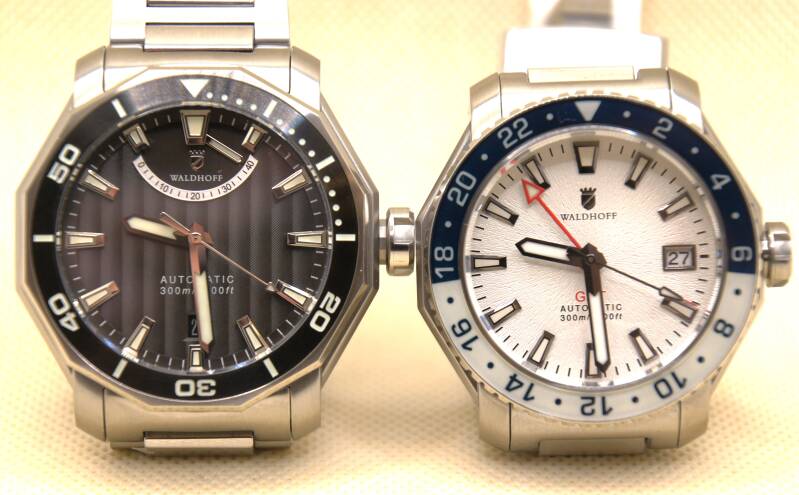

The most important similarity — and the main reason someone might think these watches are "the same" — is the octagonal stainless steel 316L case.
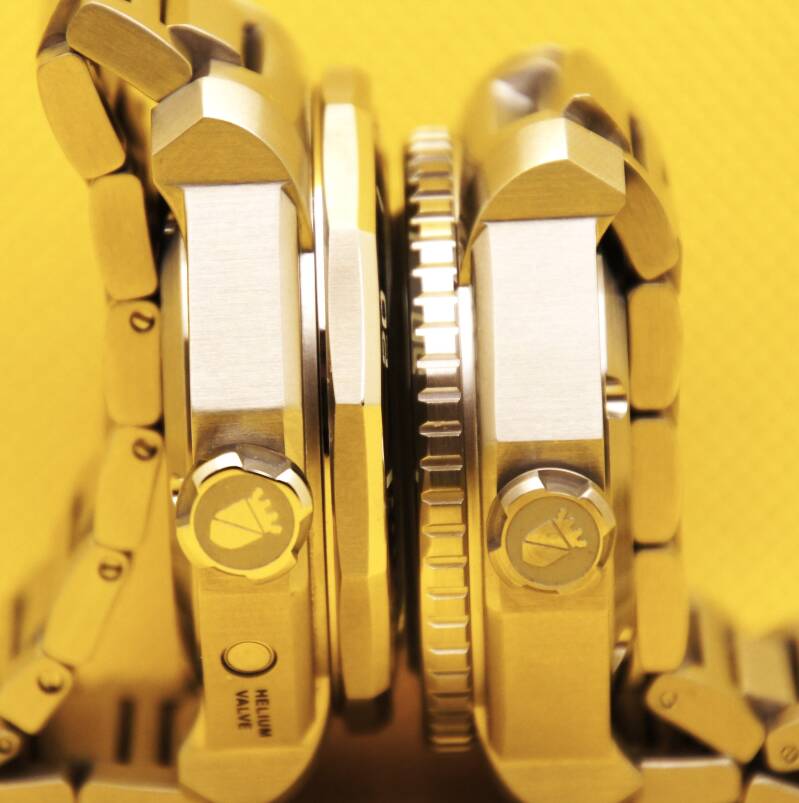
The Atlas case is, in fact, just a smaller version (41mm) of the Seawolf case (43mm) in every aspect. An exact copy. The same goes for the crowns — both signed and screw-down. The Atlas simply uses a smaller version of the Seawolf’s crown, but the design is identical. I must say that both cases are very well made — no complaints here. I particularly like the fact that the surfaces are brushed rather than polished.
However, the crown side of the watches already reveals a key difference between them. Even though both have a stated water resistance of 300 meters, the Seawolf features a helium escape valve, while the Atlas does not.
But let’s go back to the similarities and look at the hands and hour markers. As you can see, both watches use essentially the same hour and minute hands, while the second hands are similar but not identical. Although the Atlas case is smaller, the hands were not resized accordingly — they are the same as on the Seawolf. Unlike the crown, they were not proportionally shortened. You can see that the minute hand on the Atlas reaches closer to the outer edge of the dial than it does on the Seawolf.
The hands themselves are simple but effective. They do their main job well — legibility is excellent. If I were being picky, I’d say the hour and minute hands are maybe a bit too thick, but overall, I still like them. Why the second hands are different, I don’t know. I can only comment that the red tip on the Seawolf’s second hand feels out of place, as there’s no other red accent on the watch. On the Atlas, however, the red tip coordinates nicely with the red GMT hand and the red "GMT" label on the dial.
The hour markers are generally of the same design, with some adaptations due to the different date window placements and the power reserve indicator, which is positioned at the top of the Seawolf’s dial. That indicator deserves a closer look. Its hand is positioned below the 12 o’clock index, creating a visible space between the index and the dial. In fact, the Seawolf’s dial is constructed in several layers. The base dial is overlaid with a narrow inner minute track, and all the hour markers are mounted on this raised ring. This creates small gaps between the markers and the dial surface. It’s a more complex and layered design. The Atlas, by contrast, uses a more standard approach, with the index markers simply applied directly to the dial.




Even though the hands and hour markers are grey (referring to the metal frames, not the lume), they often appear completely black depending on the lighting conditions. With the Atlas, I actually had to check the official product photos to be sure of the actual colors — under certain angles, it was impossible to tell. On the Seawolf, the grey tone is much more dominant and stable, and it rarely shifts toward black.
Since I’ve already mentioned some key dial details, let’s continue with that. Both dials are made of metal, and both are visually quite interesting. The Seawolf dial is decorated with vertical Geneva stripe “pillars” that extend outward but stop at the edge of the power reserve indicator. Inside the power indicator area, the dial is smooth, with no decoration. These Geneva stripes look significantly more appealing on the white-dial version than on the black one — the texture simply pops more in lighter tones.
Even more visually striking is the Atlas dial, which features fine radial furrows running from the center outwards toward the edge of the dial. It’s a unique texture that plays with the light in a completely different way and gives the watch a refined, almost dynamic look.
What I like about both watches is the fact that the dials are not overcrowded with text. There’s just the Waldhoff logo below the 12 o’clock position and a simple “Automatic 300m / 1000ft” marking — both using the same font on each watch. The Atlas also includes a discreet “GMT” label.
The date window is placed differently on each model. On the Seawolf, a date at 3 o’clock simply wouldn’t work due to the layout, so placing it at 6 o’clock was definitely the better choice. Why the Atlas didn’t follow the same approach, I don’t know — a 6 o’clock date would have worked just as well there too. That said, the Atlas date display is better overall: it uses a cleaner, larger font that makes reading the date easier and more comfortable.
Now, let’s move on to the bezels. Here we’re looking at two completely different elements in every possible way — design, material, and function.



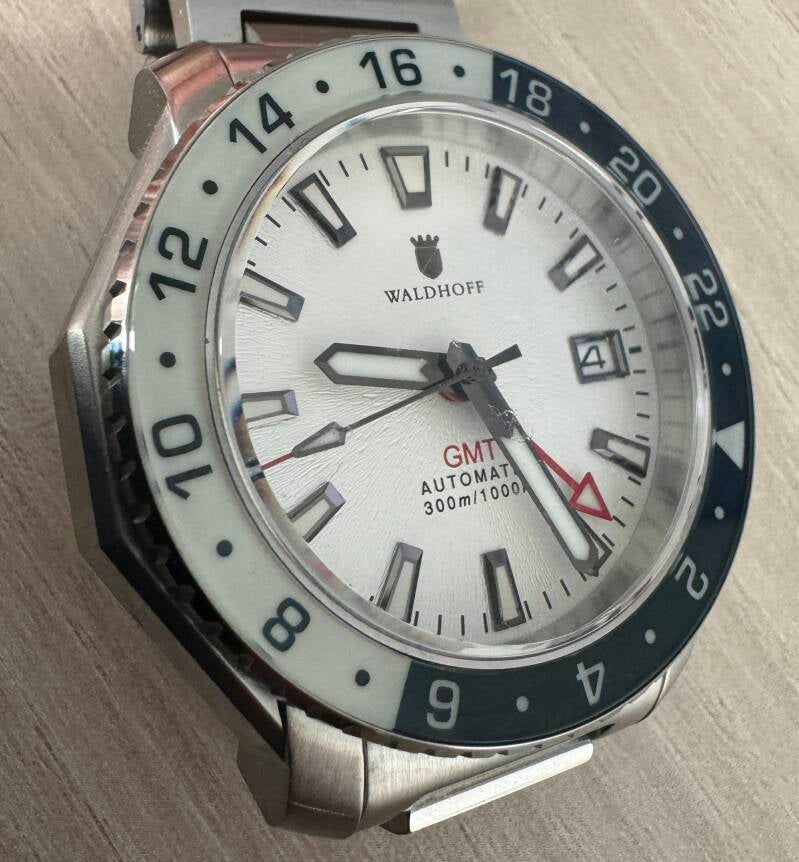
The Seawolf features a traditional, purpose-built diver’s bezel. Its shape follows the geometry of the octagonal case, and it's crafted from stainless steel with ceramic inserts. The bezel includes the expected diver's scale and offers 120 unidirectional clicks. Rotation is fairly stiff, and due to the smooth lines between the angles, it’s not the easiest bezel to grip and turn. But on the plus side, it’s extremely secure — there’s no chance of rotating it by accident. The clicks are precise, with no slack or play.
The Atlas, on the other hand, tells a completely different story. Its bezel is round with small grip teeth around the edge. It's also made of steel, but instead of ceramic, the inserts are made of glass — a modern and increasingly common choice. Unlike the Seawolf’s dive-oriented bezel, the Atlas bezel is dedicated to GMT functionality. It rotates bidirectionally with 60 clicks. Rotation is much easier than on the Seawolf, but unfortunately, it lacks the same precision — there’s a bit of slack you can feel when turning it.
So, while the Seawolf stays true to tradition and the Atlas embraces modern design, I personally find the Seawolf’s bezel to be far superior. In fact, it even makes me wonder whether the Atlas can still be classified as a proper diver’s watch, or whether it’s better described simply as a GMT watch with high water resistance.
Before moving on to the casebacks, I have to comment on what I consider the worst aspect of both watches: the crystal placement. Both use sapphire crystals with anti-reflective coating — which is great. But the crystals protrude noticeably above the bezels. On the Seawolf, it’s only a slight rise — about the thickness of a fingernail — and still acceptable. On the Atlas, however, the protrusion is much more significant. And frankly, I don’t like it. It just doesn’t look right. If the Seawolf’s design can still pass, the Atlas unfortunately crosses the line.

The casebacks once again follow the same construction — as one would expect, given the similarities in the cases. Both feature a prominent engraving related to the theme that inspired each watch’s name. The Seawolf is named after the USS Seawolf SSN-21, a nuclear-powered, fast-attack submarine, and its backplate proudly displays an engraving of the vessel.
The Atlas, by contrast, seems to draw its name from Greek mythology — specifically the Titan Atlas, after whom the Atlantic Ocean was named. The caseback features a classical depiction of the figure holding up the heavens.

Surrounding these central engravings are the usual technical details, such as water resistance, material, and movement type. However, there’s one unusual detail: instead of the common “automatic” marking, both watches are labeled with the term “rotor winding.” It’s a rare phrasing, but of course refers to the same thing.
One small inconsistency is worth pointing out. According to Waldhoff’s official website, the Seawolf comes with quick-release spring bars. But a close look at the caseback — specifically the area around the lugs — clearly shows that this is not the case. Which brings us to the bracelets.


At first glance, the bracelets on both watches appear identical. But that couldn’t be further from the truth. The first and most basic difference comes from the lug widths — 22mm on the Seawolf vs. 20mm on the Atlas.
While the overall shape of the links is the same, the way they’re connected is completely different. The Atlas uses simple friction-fit pins (thin metal rods that are extended on one side), whereas the Seawolf uses more solid, screw-in pins — a solution that is more robust and easier to work with when sizing the bracelet.
The most significant differences, however, are found in the clasps. The first and least important distinction is the size: the Atlas clasp measures 20x33 mm, while the Seawolf clasp is noticeably larger at 22x40 mm.
The real difference lies in functionality. The Seawolf features a true diver’s extension system that allows you to lengthen the bracelet in five steps, from 0 to 14 mm — a useful feature when wearing the watch over a wetsuit. However, this clasp does not offer any micro-adjustment holes.

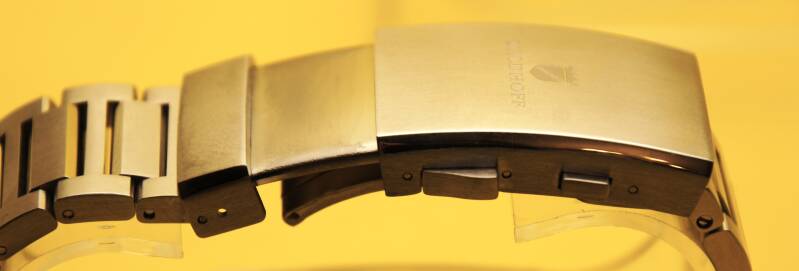
The Atlas clasp, on the other hand, is more standard. It has a single micro-adjustment hole (offering around 4 mm of adjustment), but lacks the diver’s extension feature. Its release mechanism also differs — the Atlas has a single-side push button, while the Seawolf uses dual push buttons for added security. In addition to that, the Seawolf clasp features a double-sided locking button for the diver’s extension system.




I’ve seen bracelets similar to the one on the Seawolf before — for example, on the Edox Skydiver. The clasp may look oversized at first, but in practice, it’s very comfortable and highly functional. Since there are no traditional micro-adjustment holes, I often use the first step of the diver’s extension to fine-tune the fit. Technically, there is another hole in the clasp, and I initially assumed it could serve as a micro-adjustment point. However, the link couldn’t fit into it — it was simply too wide.
On the other hand, I’ve never come across a clasp design quite like the one on the Atlas. I actually like its single-sided push-button mechanism — it’s very easy to operate and feels intuitive.

But again, just like with the bezel, the Seawolf offers a true diver’s bracelet, while the Atlas, although solid and well-built, lacks the full set of features to be considered a proper diver’s bracelet.
As for the end links — no complaints there. On both watches, they fit seamlessly into the case, giving a clean and precise look.
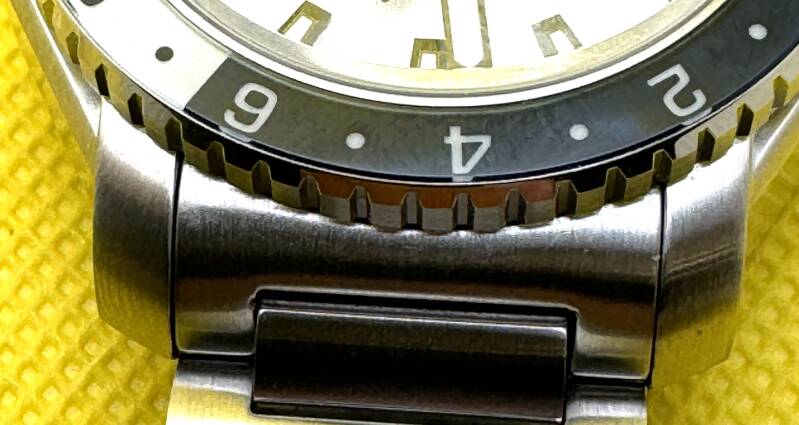


The lume is excellent on both watches. Once again, we can observe the contrast between the traditional approach of the Seawolf and the modern design of the Atlas — the latter made possible by the use of a glass bezel. Visually, the Atlas is definitely more striking in the dark, but from a functionality standpoint, I have to give the edge to the Seawolf. Its lume lasts longer and provides better overall visibility and legibility of the time. That said, I do have one small complaint. I don’t really see the need for a lumed power reserve hand on the Seawolf — its usefulness in the dark is questionable at best. Similarly, the lumed GMT hand on the Atlas is somewhat debatable.
While it’s a nice idea in theory, and it’s even executed in a different lume color than the main hands and hour markers, in practice the difference fades after a few hours. Since the GMT hand often passes directly over the hour markers, it can easily get lost in the dial and becomes hard to notice in low-light conditions.
It's finally time to say something about the movements. There isn’t much to elaborate on when it comes to the Atlas — it’s powered by the well-known Seiko NH34, a GMT version of the reliable NH35 family. A true workhorse. It performs within expected tolerances. I measured positional deviations ranging from -10 to -25 seconds per day, and on the wrist, the watch averaged around -13 seconds daily.
The Seawolf, on the other hand, features a slightly more interesting movement — the Miyota 9130. This caliber belongs to Miyota’s premium range, featuring 26 jewels and a smooth 28,800 bph beat rate. I was genuinely impressed by its accuracy. Across four positions, I measured between +2 and +5 seconds per day, while two positions showed -3 and -7 seconds. I wore the watch continuously for five days, and it maintained an average daily gain of +3 seconds on the wrist.
Since the movement also powers the reserve indicator, I could observe that charging is quick — only minimal wrist motion is needed to build up power. All in all, I’m very satisfied with this performance.
Ready for some wrist shots? I truly enjoy wearing both watches — they both feel great on the wrist.
Both watches arrived in identical packaging — all good there. I just don’t quite understand the purpose of the small “drawer” in the box. It’s completely empty. I ended up using it to store the spare bracelet links, which actually worked out well.
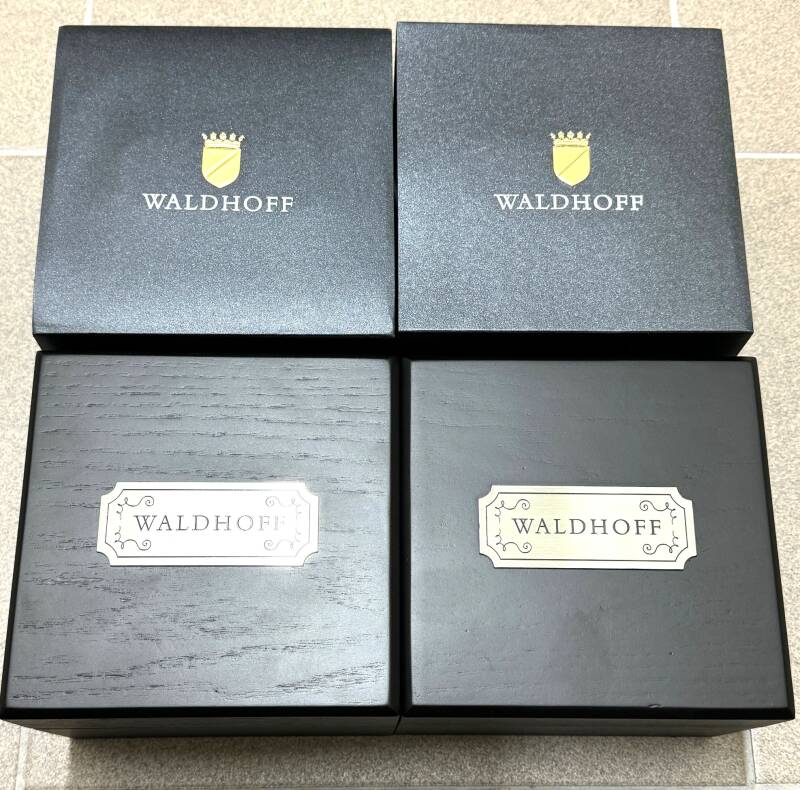
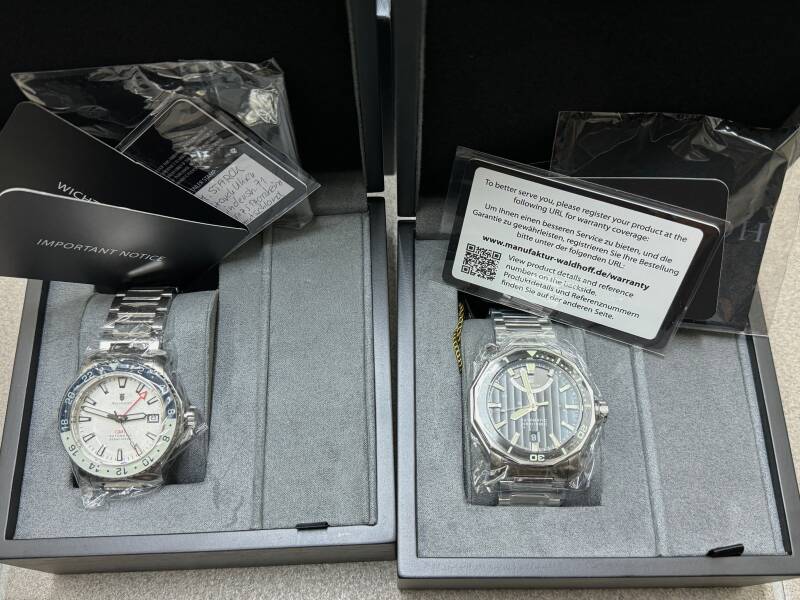
Official retail prices in the EU are as follows: the Seawolf costs €740, while the Atlas is priced at €520 on a bracelet and €420 on a NATO strap. In the US, Watches.com lists the Seawolf at $700 and the Atlas (bracelet version) at $470 — they currently don’t offer the NATO variant. I should also mention that Waldhoff’s official store offered special discounts back in February: €100 off the Seawolf and €60 off the Atlas. In addition, Watches.com often runs promotions with discounts of up to 20%.
All things considered, both watches offer great value for money. It’s hard to find a better GMT-equipped watch with a Seiko movement — or any other movement, for that matter — at the Atlas’s price point. And in my opinion, the Seawolf is priced even more attractively considering its features and build quality.
I can easily recommend both watches. But if you’ve read this far, you’ve probably already figured out that my personal favorite is the Seawolf. If I had to choose just one of the two — the Seawolf would be the winner, no hesitation.
And as a final note, speaking as a fan of rubber straps: Dear Waldhoff, if you’re going to include an empty drawer in the box... why not fill it with a high-quality rubber strap? That would make a great watch even better.












Add comment
Comments
Great in depth review! I fell for the gorgeous white dial Atlas GMT. I wear mine on a single pass elastic strap, and it wears superb! Would point out that the company website states that the Atlas bezel insert is actually sapphire as well.